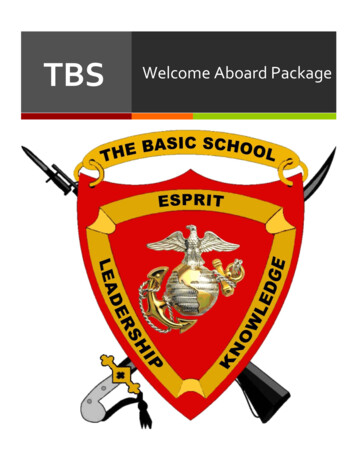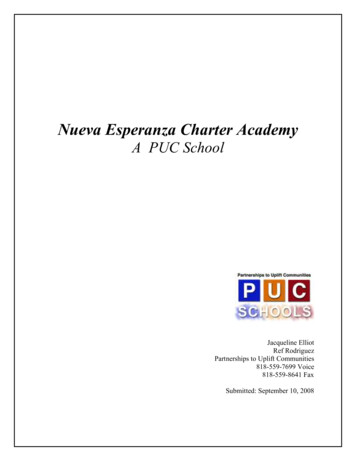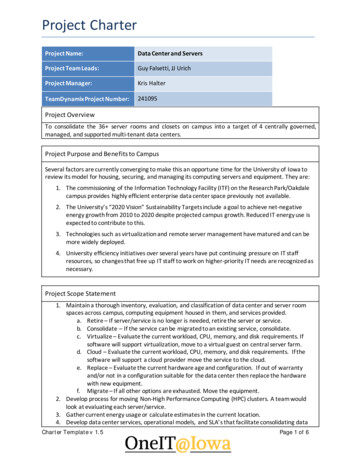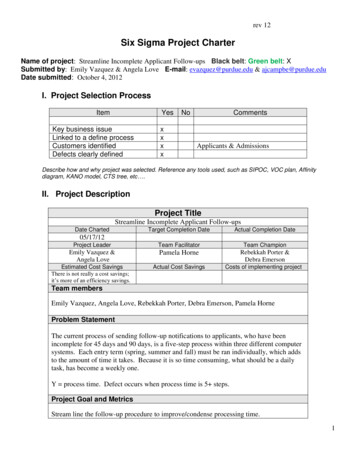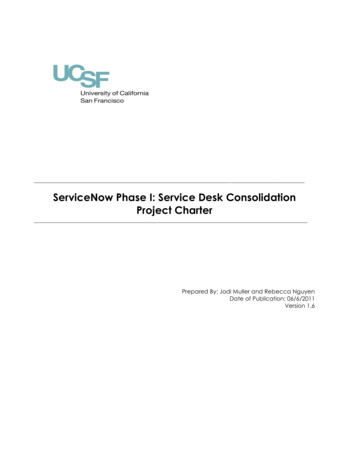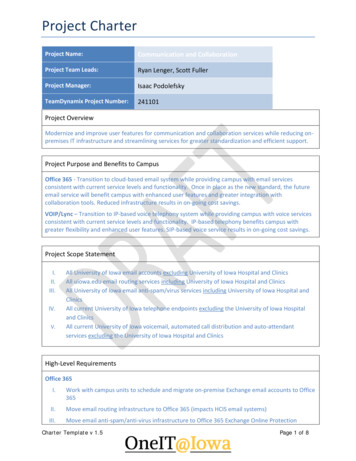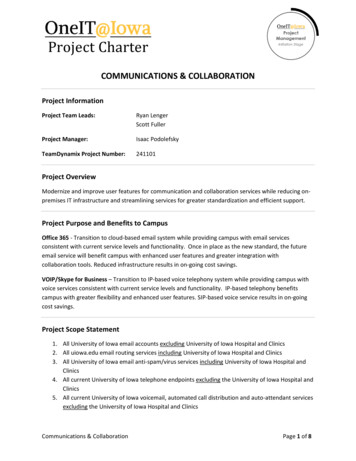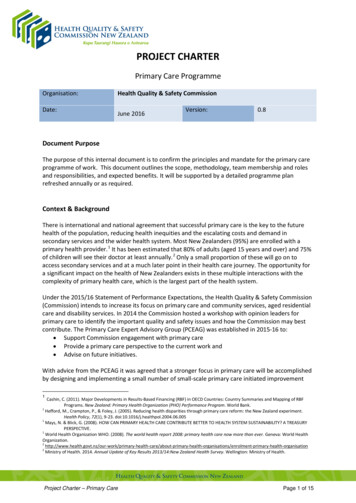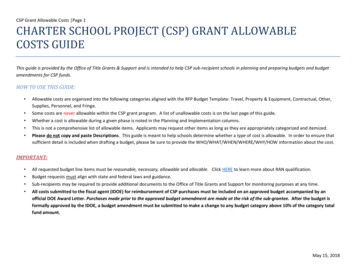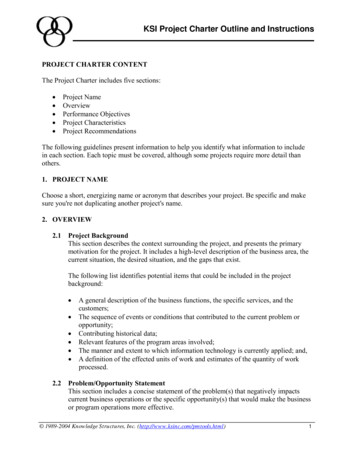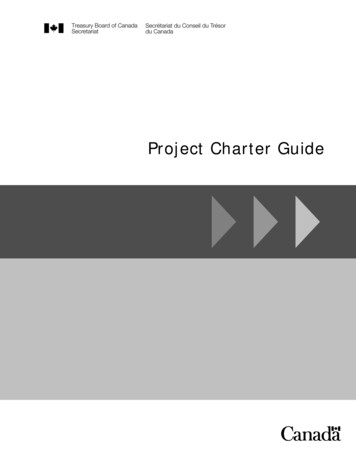
Transcription
Project Charter Guide
Feedback and QuestionsTo help maintain the currency of this document, feedback and questions are welcomed.Please contact:IT Project Review and OversightChief Information Officer BranchTreasury Board of Canada SecretariatOttawa ON K1A 0R5CanadaEmail: itprod-despti@tbs-sct.gc.ca Her Majesty the Queen in Right of Canada,represented by the President of the Treasury Board, 2008Catalogue No. BT48-4/2-2008E-PDFISBN 978-1-100-11473-6This document is available on the Treasury Board of Canada Secretariat’swebsite at http://www.tbs-sct.gc.ca.This document is also available in alternative formats on request.
Table of ContentsIntroduction. 1Use of the Project Charter. 1What is a project charter? . 1Why create a project charter? . 1Who is responsible for the project charter? . 1How to create a project charter . 2Tailoring the project charter to specific projects. 2Use of the Project Charter Guide . 6Section 1. Charter Introduction. 71.1 Document change control . 71.2 Executive summary . 71.3 Authorization . 7Section 2. Project Overview . 82.12.22.32.42.52.62.72.8Project summary . 8Project goals, objectives, and business outcomes . 8Project scope . 9Milestones . 9Deliverables . 10Project cost estimate and sources of funding . 11Dependencies . 12Project risks, assumptions, and constraints . 13Section 3. Project Organization . 143.13.23.33.4Project governance .Project team structure.Roles and responsibilities .Project facilities and resources.14151616Section 4. Project References . 17Section 5. Glossary and Acronyms . 17Appendix: Roles and Responsibilities Matrix. 19Bibliography. 22
IntroductionThis guide explains the steps needed to create a project charter for the delivery of a project. Theguide is meant to be used together with a document called the Project Charter Template, and,where relevant, it includes examples to illustrate the content.The first section, titled “Use of the Project Charter,” gives background information on thepurpose of the charter, who is responsible for creating it, work that should be carried outbeforehand in order to prepare the charter, how the charter should be customized, and keysections required at the beginning.Use of the Project CharterWhat is a project charter?The project charter is a “document issued by the project initiator or sponsor that formallyauthorizes the existence of a project, and provides the project manager with the authority toapply organizational resources to project activities.”1In addition to its contract purpose, the project charter includes most elements of a preliminaryproject scope statement, which describes what is and what is not included in the project. It alsohelps to control changes to the scope of the project throughout its duration or life cycle. Theintent is to cover, in a single document, all activities of the initiating process group2 as defined inA Guide to the Project Management Body of Knowledge.Why create a project charter?As a comprehensive overview of the project, the project charter allows all parties involved(stakeholders) to reach agreement and document major aspects of the project such as theobjectives, the scope, the deliverables, and the resources required. The charter supports thedecision-making process and is also often used as a communication tool.Who is responsible for the project charter?The project charter should normally be developed by the project sponsor or a manager externalto the project team. In practice, however, the project manager often plays a major role in thedevelopment of the project charter. The project manager works closely with the project sponsor,who provides background information for the project (e.g. purpose of the project and linkages to1. Project Management Institute (2004). A Guide to the Project Management Body of Knowledge, Third Edition, p. 368.2. Those processes performed to authorize and define the scope of a new phase or project or that can result in the continuation ofhalted project work.Project Charter Guide1
business needs, strategic priorities, objectives, and outcomes). The project manager alsointerviews stakeholders to gain more information in order to develop the charter.How to create a project charterThis guide supports a template that was developed to highlight all standard elements that shouldbe covered in the project charter to formalize a project. The template can be obtained his guide also contains a section called “Use of the Project Charter Template” that explainshow to complete each topic covered in the template.Tailoring the project charter to specific projectsRegardless of the size and type of project, the elements of a project charter are the same, just asthe fundamental project management processes and principles remain the same. Although thedepth and scope of applying these processes and principles may change from project to project,the project framework remains constant.Adapting the project charter to the Treasury Board of Canada Secretariat’s ProjectComplexity and Risk Assessment ToolThe project manager is expected to provide a comprehensive overview of the project in theproject charter. The following table lists, in the left column, four classes of projects and suggestssome areas to consider when developing a project charter, based on the results obtained througha risk assessment. This assessment would be contained in the business case for the project. Tohelp with a risk assessment, a Project Complexity and Risk Assessment Tool is underdevelopment.2Treasury Board of Canada Secretariat
Sustaining ProjectDescriptionRisk ConsiderationsProject Charter ConsiderationsThe primary project goalis to sustain service froman existing asset byaddressing agingcomponents ordeficiencies that limit itsongoing use. It is not aredevelopment.Low to no requirements risk.Business changes are largelycosmetic—e.g. a serviceenhancement or versioningupdates.Scope definition and boundaries shouldbe limited to a single system or assetwithin a single program.Negligible new capabilityor functionality added.Business-initiatedchanges are likelyminimal.Scope confined to asingle system or assetwithin a single program;one or few stakeholders.Business processes areessentially unchanged,although technologyinterfaces may be different—minimal retraining is requiredat the business level. Minimalchange management.Risks more likely associatedwith technology thanbusiness. Higherimplementation risks insystems with demandingperformance or availability(i.e. non-functional)characteristics.Usually one or few stakeholders.Prerequisites, assumptions, andconstraints should address potentialdisruption to current operations.Deliverables should be expressedmostly in terms of updates to existingproduct, service, or result.Cost estimate should determine if theupdates affect the ongoing costs(operation).Risks and interdependencies shouldinclude technology and implementationrisks (such as parallel run or businessdisruption).“Project References” section shouldrefer to a requirements document.Project Charter Guide3
Evolutionary ProjectTactical ProjectDescription4Usually driven by animmediate businessneed to deliver anadditional capability,often within a limitedtime frame, or to positionan existing asset foranticipated needs byadding capability.Capability added may befunctional or nonfunctional.Risk ConsiderationsChanges and additions tobusiness processes arerequired with small- tomedium-scale changemanagement. Effect is oftenlocalized to a specificsegment of the business.Medium to high requirementsrisk and related risk of scopecreep; development riskincreases according to portionbeing redeveloped or added.Scope may involvemultiple systems,programs, ororganizational entities(departments) but with aclear authority and asimple governancestructure.Technology risk may be highif significant performance oravailability (i.e. non-functional)enhancements required.Major changes andadditions to capability,affecting businessprocesses, job content,and service deliverymodel. Often acombination of businessand technology evolutionis involved.High business risk due tosignificant changemanagement and businessprocess change. The morepervasive the effect of thesolution across the business,the greater the risk.Some base componentsare reused to provide aworking platform onwhich to add function.Scope may involvemultiple systems,programs, entities, orjurisdictions and mayoverlap with client andbusiness systems,requiring an appropriategovernance structure.Implementation risk medium,ranging to high if underlyingtechnology base replaced.High requirements risk andrelated risk of scope creep,hence significant delivery risk.Governance risk proportionalto number and diversity ofstakeholder interests.Conversion andimplementation risks likely tobe high, includingorganizational change.Treasury Board of Canada SecretariatProject Charter ConsiderationsThe charter and risks should show agreater progression in the level ofproject management from Sustaining toTransformational, i.e. identify moredetailed considerations with increasedcomplexity and risk to support projectscope, time, and cost managementrequirements.Scope should clearly indicate thebusiness processes that are affected.Time constraints should be documented.Interdependencies with multiplesystems, programs, or organizationalentities (departments) and consequentrisks should be addressed.The governance and roles andresponsibilities should be well defined.“Project References” section shouldrefer to a requirements document.Conversion and implementationactivities should be visible in theschedule and cost estimates.Special attention should be paid tointerdependencies between the projectand business processes.Governance should be welldocumented.Roles and responsibilities of thestakeholders and the governance bodiesshould be described.Human resources strategy to addresschanges to the organization should bedocumented.
Transformational ProjectDescriptionProject will changefundamentals about theway the business areaworks, such asprocesses, job content,organization,outsourcing, client andbusiness involvement,and service model.Few if any existingcomponents will bereused.Project likely spansorganizational entities;may be multijurisdictional, involvemultiple stakeholders,and require a complexgovernance structure.Risk ConsiderationsCarries all the risks of theEvolutionary class of projects,further increased by theabsence of any significantreuse.High to very high businessrisk due to project size; veryhigh change managementimplications; and pervasiveeffect of change across thebusiness.High to very high governancerisk.High conversion andimplementation risk, variabletechnology risk.Few if any risk mitigators arevisible.Project Charter ConsiderationsInterdependencies with processes,systems, and people should bedocumented.Significant risk contingency should beapplied to the cost and effort estimates.The “Project Organization” sectionshould be the object of particularattention.Project facilities and resources are oftena consideration for Transformationalprojects.Interdependencies between the differentstakeholders should be presented in theproject governance section.The change management strategyshould be described.Organizational Project Management Capacity AssessmentAt the time of the publication of this guide, a new tool called an Organizational ProjectManagement Capacity Assessment was being test piloted with select government departments.Authors of a project charter will be invited to analyze the results of their organizations.In this assessment, the knowledge areas with the lowest scores, which indicate lower projectmanagement capacity, should be addressed in the project management plan. This will help toensure that the project charter addresses any issues or concerns regarding the capacity of theorganization to implement the project.Project Charter Guide5
Use of the Project Charter TemplateThis guide explains how to complete the Project Charter Template and gives some insight intothe content expected for each of the subjects listed in the template document.Using this TemplateDocument Purpo
The project charter is a “document issued by the project initiator or sponsor that formally authorizes the existence of a project, and provides the project manager with the authority to apply organizational resources to project activities.” 1
